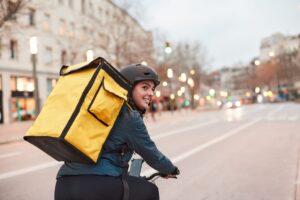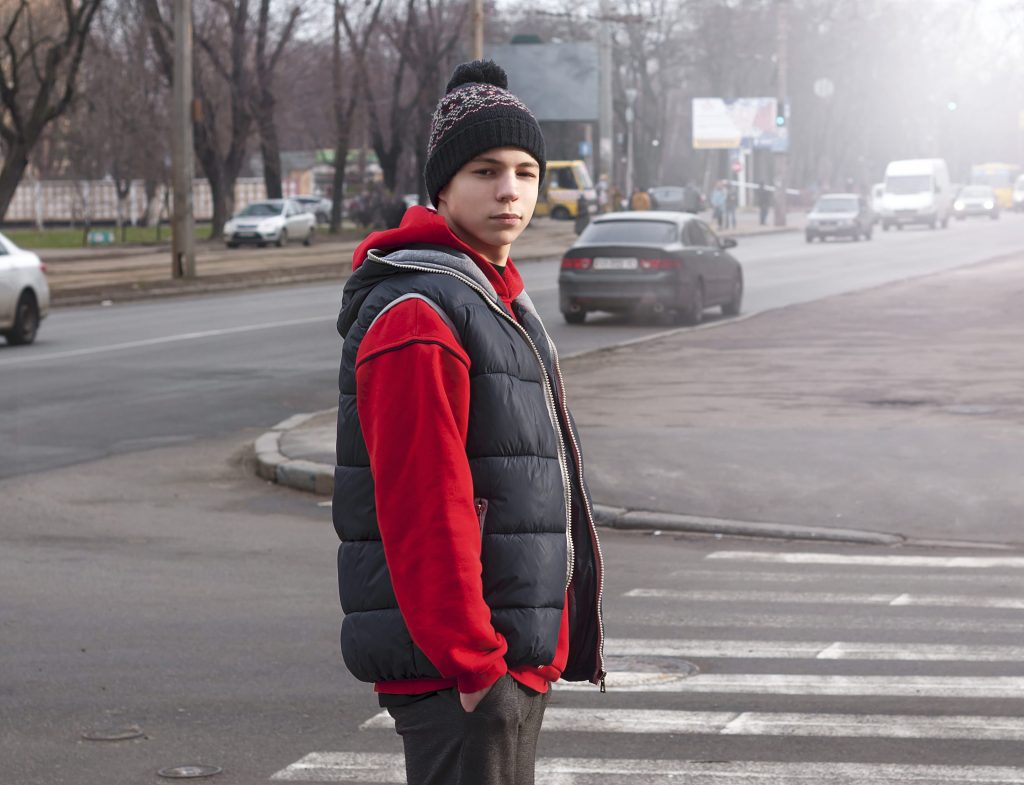Safety is a Two-Way Street
During the winter months there are shorter daylight hours and roads, and sidewalks are slippery. It can take some adjustment for people walking, cycling, and driving on our roadways to focus on sharing the road with one another. During the past several years the number of pedestrian injuries and fatalities in New Jersey have increased. You can help to be safe this fall by following these tips while traveling:

For Cyclists/ E-Scooters
- Use hand signals – so drivers and motorcyclists know which direction you are headed.
- Use lights –NJ requires a white light on the front and red light on the back when riding at night.
- Wear a helmet – state law requires anyone under 17 to wear a helmet.
- Obey all traffic laws– keep right, stop at red lights and stop signs.
- Maintain your vehicle– salty, slushy roads can damage your bike. Wipe your bike and scooter down every ride to avoid rust and check your tire pressure.

For Pedestrians
- Use crosswalks and cross at intersections – make eye contact with drivers, motorcyclists, cyclists and scooters before
- Use sidewalks when available – if not stay close to the curb and walk facing traffic.
- Obey WALK/DON’T WALK signs.
- Have a clear view – remove hoods and anything covering your face, especially when crossing the street, promoting safer interactions with all roadway users.

For Everyone
- Cross the street in a well-lit area – under streetlights or near crosswalks if available. If not, use your phone as a flashlight and cross at corners. Using lights will ensure that motorcyclists, cyclists, and scooter riders can see you.
- Avoid being distracted– by your phone and wearing headphones, especially when crossing.
- Avoid alcohol and other drugs – it can slow your reaction time and alter your balance when riding or walking. This is crucial for your safety and the safety of motorcyclists, cyclists, delivery workers, scooter riders, and pedestrians who share the road with you.
47.5
million people in the US ride their bike annually
193
pedestrians killed on NJ roadways in 2022
5
is the average age when most kids learn to ride a bike
Walk This Way!
5 Tips to Stay Safe this Winter
Walking, biking, riding scooters, or skateboards is fun and a great way to stay healthy. As the days get shorter and nighttime increases, it is important to remember to practice safe habits.
- Find a safe route –map out a safe way to get to your destination ahead of time. Some routes may have more sidewalks and less traffic than others.
- Better late than unsafe– when we rush, we tend to make unsafe decisions. Keep in mind the after-work rush is much busier this time of year. Stay focused and aware of your surroundings.
- Be predictable– always cross at corners and use crosswalks, so other roadway users know where you are headed; it may be quicker to cut across to the parking lot, but it is not safe!
- Ride to the right –and in a single file when riding your bike
- No distractions – make sure you look up and listen when crossing. Your eyes and ears are your best defense when walking.

- Anyone under 17, must wear an approved helmet. We recommend all ages!
- Bikes must be equipped with a bell or horn that is audible up to 100 ft.
- Bikes are required to have lights on the front and back, that can be seen from 50 ft.
- Obey all the traffic laws and use hand signals so vehicles know where you are headed.
- Cyclists should always ride single file, or two alongside each other when traffic is not impeded.
Wearing a helmet to protect your head in the event of a crash is a no brainer. But wait! Before you strap on that helmet on yourself or a child, make sure your helmet:
- Is designed for your activity (bicycle helmets are different than those for skateboarding/rollerblading)
- Fits properly
- Does not have any cracks or defects
- Has a SNELL or ASTM seal of approval on it.
- Is replaced every 3-5 years
Check out these brochures to learn more about bike safety for you and your kids:
FACT:
75% of pedestrian fatalities occur in the dark. Be extra cautious when walking at night.

As a motorist, be mindful of pedestrians at crosswalks and intersections as well as in downtown areas where pedestrians tend to cross.
When driving always keep your eyes open for different types of pedestrians including:
- Children – especially near schools, playgrounds and neighborhoods
- Dog walkers
- Skateboarders
- Runners and walkers
- Bicyclists
- Seniors and others with assistive devices such as canes, walkers or wheelchairs
- Workers
- School crossing guards

Whether you have kids or are just passing through towns as children are playing, parents and motorists have a responsibility to help ensure the safety of children and teens.
- Have children play in areas away from busy streets, driveways and parking lots
- Make sure young children are accompanied by an adult, especially when crossing streets
- When there is no sidewalk, walk close to the curb facing traffic
- When playing later in the day, children should be in bright or reflective clothing.
- Teach older children to cross in well-lit areas and use their cellphone flashlight to be visible to drivers when crossing.

From construction workers to landscapers — lots of people work on and near roadways. Make sure you “Give them a Brake” by slowing down and allowing space for them to work safely. In many cases these workers are using equipment that may prevent them from hearing vehicles coming. Keep your eyes out for:
- Sanitation workers
- Landscapers
- Tow-truck operators
- Police & Emergency Responders
- Crossing guards
- Utility workers
- Construction workers
- Mail/package carriers

